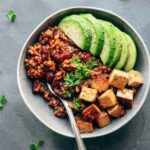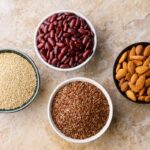Embark on a culinary journey with “Cooking Made Simple: Delicious Soy-Free Recipes You’ll Crave,” a guide designed to unlock a world of flavorful, accessible dishes, even without soy. Imagine vibrant colors, tantalizing aromas, and textures that dance on your palate – all achievable with simple techniques and readily available ingredients. This isn’t just about avoiding soy; it’s about discovering new culinary horizons, creating satisfying meals, and expanding your cooking repertoire with confidence.
We’ll explore diverse recipes, from beginner-friendly options to more adventurous creations, offering detailed step-by-step instructions and helpful tips to navigate common pitfalls. Learn how to substitute ingredients, balance flavors, and master techniques to achieve professional-looking results. Discover the nutritional benefits of soy-free cooking and how to adapt recipes to suit various dietary needs, ensuring everyone can enjoy these delicious and healthy meals.
Step-by-Step Cooking Guides
This section provides a detailed guide for preparing one of our delicious soy-free recipes: Creamy Coconut Curry with Chickpeas and Sweet Potatoes. We’ll walk you through each step, highlighting key techniques and visual cues to ensure a successful and flavorful outcome. Following the recipe, we’ll address common pitfalls in soy-free cooking and offer solutions, as well as demonstrate how to adapt this recipe to various dietary needs.

Creamy Coconut Curry with Chickpeas and Sweet Potatoes: A Step-by-Step Guide
This vibrant curry is packed with flavor and texture, a perfect example of how delicious and satisfying soy-free cooking can be. The rich coconut milk base creates a creamy sauce that beautifully complements the sweet potatoes and chickpeas.
- Prep the Vegetables: Begin by peeling and dicing one large sweet potato into roughly 1-inch cubes. Imagine the sweet potato, a vibrant orange hue, transforming into perfectly uniform cubes, ready to release their sweetness into the curry. Finely chop one medium onion, its layers separating like delicate petals, and mince two cloves of garlic, their pungent aroma already hinting at the flavor to come. You should also finely chop one red bell pepper, its bright red color promising a visual feast alongside the fragrant spices.
- Sauté the Aromatics: Heat two tablespoons of coconut oil in a large pot or Dutch oven over medium heat. The oil shimmers as it warms, creating a gentle heat that will perfectly coax the flavors from the onion, garlic, and red bell pepper. Add the chopped onion and sauté until softened and translucent, approximately 5 minutes. Then, add the minced garlic and red bell pepper, continuing to sauté for another 3-4 minutes until fragrant and slightly softened. The vibrant colors of the vegetables will deepen and intensify as they cook, a visual indication of their readiness.
- Bloom the Spices: Add one tablespoon of curry powder, one teaspoon of turmeric, and half a teaspoon of cumin to the pot. Stir continuously for about 30 seconds, allowing the spices to bloom and release their aromatic oils. The spices will transform from their muted powder form into a vibrant, fragrant blend, filling your kitchen with a warm, inviting aroma. This step is crucial for unlocking the full depth of flavor in your curry.
- Add the Sweet Potatoes and Chickpeas: Stir in the diced sweet potatoes and one 15-ounce can of chickpeas (drained and rinsed). The chickpeas, once pale, will soon be coated in the fragrant spice mixture, preparing them to absorb the rich flavors of the coconut milk. Add one cup of vegetable broth and bring the mixture to a simmer.
- Simmer and Thicken: Reduce the heat to low, cover the pot, and simmer for 15-20 minutes, or until the sweet potatoes are tender. The sweet potatoes will soften, their edges becoming rounded and their color deepening slightly. Stir occasionally to prevent sticking. During the last 5 minutes of simmering, stir in one 13.5-ounce can of full-fat coconut milk, allowing it to gently heat and create a creamy, luxurious sauce.
- Season and Serve: Season with salt and pepper to taste. Garnish with fresh cilantro, if desired. The finished curry will be a rich, vibrant orange-red hue, the sweet potatoes tender and the chickpeas perfectly coated in the creamy coconut sauce. Serve hot with brown rice or naan bread (ensure it’s soy-free!).
Common Mistakes to Avoid When Preparing Soy-Free Dishes
Soy is a common ingredient in many processed foods, so avoiding it requires careful attention to labels and ingredient lists. Many sauces, condiments, and even some seemingly simple ingredients can contain hidden soy. Paying attention to these points will ensure success in your soy-free cooking endeavors.
- Hidden Soy: Many processed foods contain soy in unexpected places, such as Worcestershire sauce, certain types of bread, and some vegetarian meat substitutes. Always carefully check ingredient labels.
- Cross-Contamination: Be mindful of cross-contamination when preparing soy-free dishes in a kitchen that also handles soy products. Use separate cutting boards, utensils, and cooking surfaces to avoid accidental mixing.
- Improper Ingredient Substitutions: Not all soy substitutes are created equal. When substituting soy sauce, for example, ensure you choose a soy-free alternative like coconut aminos or tamari (check labels carefully as some tamari brands contain wheat). A poor substitution can significantly alter the flavor profile of your dish.
Recipe Adaptations for Different Dietary Needs
This table Artikels how to adapt the Creamy Coconut Curry recipe to accommodate various dietary needs.
| Dietary Need | Adaptation |
|---|---|
| Vegan | This recipe is already vegan. |
| Vegetarian | This recipe is already vegetarian. |
| Gluten-Free | Ensure that your curry powder, vegetable broth, and any other added ingredients are certified gluten-free. Use gluten-free naan or brown rice for serving. |
Ingredient Sourcing & Substitutions
Navigating the world of soy-free cooking requires understanding both readily available ingredients and suitable replacements for common soy-containing products. This section will illuminate key ingredients, explore their sourcing, and provide practical substitutions to ensure your culinary creations remain both delicious and free from soy.
Key Soy-Free Ingredients
The foundation of successful soy-free cooking rests on a selection of versatile and nutritious ingredients. Understanding their availability, cost, and nutritional benefits is crucial for creating flavorful and healthy meals.
- Coconut aminos: A popular soy sauce alternative, coconut aminos are derived from the sap of coconut trees. They are widely available in health food stores and increasingly in mainstream supermarkets, with prices comparable to soy sauce. Nutritionally, they offer a good source of electrolytes and trace minerals, though sodium content should be considered. Imagine the rich, subtly sweet aroma and dark, viscous consistency, adding depth to stir-fries and marinades.
- Chickpeas: A nutritional powerhouse, chickpeas are a readily available and affordable legume. Found in most grocery stores, they are an excellent source of protein and fiber. Their versatility shines through in hummus, curries, and salads. Picture their creamy texture when mashed, or their satisfying firmness when roasted.
- Tofu alternatives (tempeh, seitan): While tofu is soy-based, tempeh (fermented soybeans) and seitan (wheat gluten) offer similar textures and functionalities. Tempeh is readily available in many supermarkets and health food stores, while seitan may require a more specialized search. Both are good sources of protein, with tempeh offering additional probiotics. Tempeh’s earthy, slightly nutty flavor contrasts with seitan’s more neutral, meaty profile.
- Nutritional yeast: A deactivated yeast with a cheesy, nutty flavor, nutritional yeast is a fantastic source of B vitamins and protein. It’s easily found in health food stores and some larger supermarkets. Its affordability and versatility make it a valuable addition to any soy-free pantry. Imagine its vibrant yellow hue and its ability to transform simple dishes with its umami richness.
- Avocado oil: A high-quality cooking oil with a high smoke point, avocado oil offers a mild flavor and a rich source of monounsaturated fats. While it may be slightly more expensive than some other oils, its nutritional benefits and flavor neutrality make it a worthwhile investment for many soy-free recipes. Visualize its vibrant green hue and its ability to enhance the flavor of roasted vegetables without overpowering them.
Soy-Based Ingredients and Their Alternatives
Many recipes rely on soy-based ingredients. Fortunately, numerous effective alternatives exist, preserving both flavor and texture.
| Soy Ingredient | Soy-Free Alternative |
|---|---|
| Soy Sauce | Coconut aminos, tamari (if gluten-free is not a concern) |
| Soy Milk | Almond milk, coconut milk, oat milk |
| Soy Lecithin | Sunflower lecithin |
| Soy Flour | Chickpea flour, almond flour |
| Textured Vegetable Protein (TVP) | Quinoa, lentils, mushrooms |
Impact of Different Cooking Oils
The choice of cooking oil significantly impacts the final taste and texture of your soy-free dishes. Different oils possess varying smoke points, flavor profiles, and nutritional compositions.
For instance, olive oil, with its distinct fruity flavor, is ideal for low-heat cooking like salad dressings or sautéing delicate vegetables. Its relatively low smoke point makes it unsuitable for high-heat frying. Imagine its rich, golden-green color and its ability to enhance the natural flavors of fresh ingredients. In contrast, avocado oil boasts a higher smoke point, making it suitable for higher-heat cooking methods such as stir-frying or roasting. Its mild flavor allows the other ingredients to shine. Finally, coconut oil, with its distinct aroma and flavor, is well-suited for baking or adding a tropical touch to certain dishes. Its characteristic white color and solid state at room temperature transform into a clear liquid when heated, adding a unique element to both sweet and savory preparations.
With “Cooking Made Simple: Delicious Soy-Free Recipes You’ll Crave,” you’ll not only master the art of soy-free cooking but also unlock a world of culinary creativity. The vibrant colors, tantalizing aromas, and delightful textures of these recipes will transform your kitchen into a haven of delicious possibilities. From simple weeknight dinners to impressive gatherings, you’ll confidently create meals that are both satisfying and healthy, proving that delicious food doesn’t require soy. So, gather your ingredients, embrace the process, and savor the joy of creating exceptional soy-free meals.
Common Queries
What are the best substitutes for soy sauce?
Coconut aminos, tamari (if gluten-free is not a concern), or a combination of Worcestershire sauce, rice vinegar, and maple syrup can effectively replace soy sauce.
Can I freeze soy-free dishes?
Many soy-free dishes freeze well. Consider the ingredients; some sauces or vegetables might change texture upon freezing. Properly store in airtight containers for optimal quality.
Are all soy-free recipes automatically gluten-free?
No. Many soy-free recipes use gluten-containing ingredients like wheat flour or soy sauce alternatives containing gluten. Always check ingredient lists carefully.
How can I make my soy-free dishes more flavorful?
Experiment with herbs, spices, citrus juices, and flavorful oils. Don’t be afraid to try bold flavor combinations and adjust seasonings to your preference.


